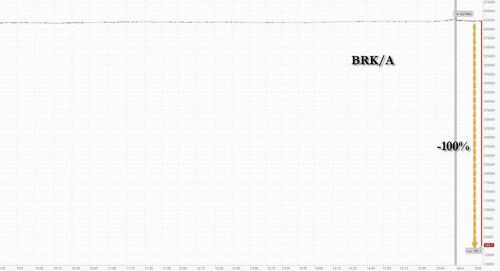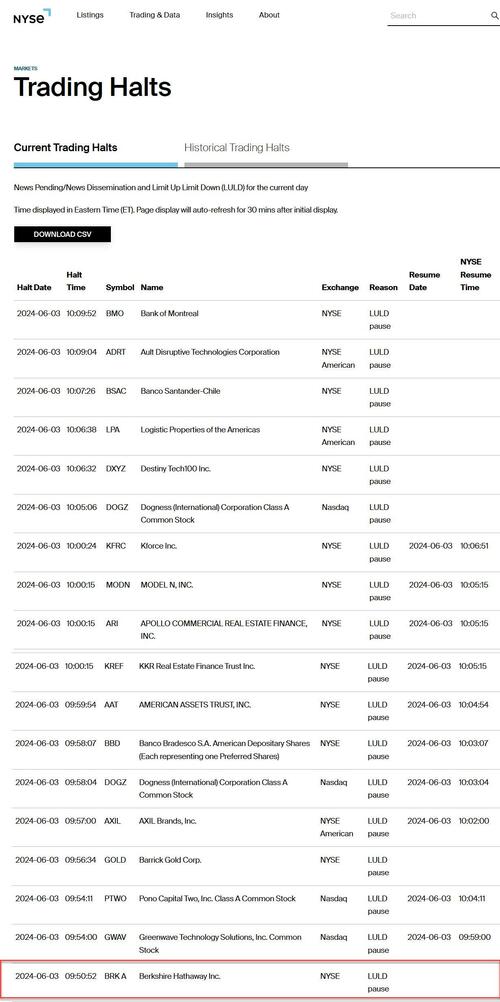Software Update "Glitch" Blamed For NYSE Market Break That Sparked Berkshire Wipe Out, Trading Halt Cascade
Update (8:00pm ET): In a flashback to the early 2010s when markets broke on a daily basis, we are back to blaming "glitches" for broken markets and flash crashes.
Hours after a new generation of traders experienced a partial market flash crash that wiped out the entire market cap of Berkshire Hathaway and halted trading on about 40 other stocks after their circuit breakers were triggered, Bloomberg reports that the culprit was a "glitch" during a software update early on Monday.
The disruption, the third such episode to hit otherwise peaceful US markets in the past week, was resolved after roughly 45 minutes when the Consolidated Tape Association, whose systems are operated by a NYSE subsidiary, reverted to a backup data center running a different software version. NYSE said it will cancel the bad trades in Berkshire Hathaway and is reviewing the erroneous halts to determine whether to cancel any of those.
The forced pauses, which began shortly before 9:45 a.m. in New York, came as CTA was rolling out a change in the software that governs which opening prices display on the Securities Information Processor, the feed that consolidates bid and ask quotes made on various exchanges.
As noted earlier, about a dozen trades in Berkshire Class A shares went off at $185.10 around 9:50 am ET before trading was halted. The stock closed Friday at $627,400. NYSE said any trade between 9:50 and 9:51 at or below $603,718.30 will be canceled. NuScale Power had a similar glitch, with trades that printed at about 99% below the prior price.
The sudden disruption did not affect Nasdsaq-listed shares and had minimal impact on the broader market, though it came as trading infrastructure adapts to one-day settlements from two, known as T+1. A glitch Thursday left the S&P 500 Index without live pricing for more than an hour. Two days earlier, an exchange had problems interfacing with the data dissemination feed.
“A little weird, but almost undoubtedly coincidental,” said Steve Sosnick, chief strategist at Interactive Brokers LLC, of the NYSE issue after last week’s S&P 500 Index glitch. “We’ve gotten used to huge amounts of uptimes without exchange incidents, so when a couple of glitches in a row occur it is notable.”
“I would assume that those bad trades will be broken,” Jonathan Corpina, NYSE floor trader and senior managing partner at Meridian Equity Partners, told Bloomberg. “I’m more curious how did this happen? I understand what happened, but I want to understand how?”
The limit up-limit down trading bands typically govern when stocks are paused for volatility. The SIP is a single data feed where regulatory bodies process and consolidate bid and ask quotes and trades from all US exchanges. Equities trading in the US is executed on more than a dozen exchanges, with all of the bid and ask orders consolidated on data feeds that are distributed worldwide. NYSE, which is owned and operated by Intercontinental Exchange Inc., operates multiple exchanges including NYSE Arca and NYSE American.
The firm consolidates order data from various exchanges at the Consolidated Tape Association. Together, those constitute Tapes A and B. Nasdaq Inc., owner of the Nasdaq exchanges, operates a separate consolidated feed known as Tape C. Volumes on American exchanges are calculated by adding the three tapes.
As Bloomberg notes, the disruptions are reminiscent of a confusing episode in January 2023, when a staffer at the New York Stock Exchange’s backup data center in Chicago left a backup system running in an error that led to wild price swings for hundreds of stocks when the market opened.
“Whether a coincidence or not, it is certainly causing a pile of confusion on the street for the second session out of the last three,” Dave Lutz, head of ETFs at JonesTrading, said in a message.
* * *
Update (12:02pm ET): After a cascade of circuit breakers pushed various NYSE stocks and instantly halted trading, the Exchange said in an email that the technical issue with industrywide price bands published by the CTA SIP has been resolved and all systems are currently operational.
- All impacted stocks have reopened
- Price band issue has been resolved
- Issue triggered trading halts in a number of NYSE listed stocks
As we noted earlier, the technical error at the New York Stock Exchange resulted in numerous erroneous trading volatility halts, including for Berkshire, Chipotle and Abbott :abs, and odd trades in at least two stocks early in the cash session Monday. Bloomberg adds that the forced pauses, which began shortly before 9:45 a.m. in New York, were resolved not long after 11 a.m. and the stocks resumed normal trading, according to statements from NYSE. The firm said a technical issue with the “industry-wide” price bands published by the Consolidated Tape Association Securities Information Processor led to the halts.
As we also noted earlier, trades Berkshire Hathaway/A shares appeared to go off at mistaken prices. About a dozen trades showed shares changed hands at $185.10 around 9:50 a.m., a discount of 99.97% to Friday’s closing price of $627,400. NuScale Power had a similar glitch, with trades that printed at about 99% below the prior price.
“It’s very confusing that it’s happening in just a few shares,” said Jonathan Corpina, senior managing partner at Meridian Equity Partners, who typically works on the floor of the NYSE. “I would assume that those bad trades will be broken.”
A representative for NYSE declined to comment on the matter beyond the exchange’s market status update page. Intercontinental Exchange Inc. is the owner of the New York Stock Exchange.
The limit up-limit down trading bands typically govern when stocks are paused for volatility. The SIP is a single data feed where regulatory bodies process and consolidate bid and ask quotes and trades from all US exchanges. The sudden disruptions Monday come just days after a glitch left the S&P 500 Index without live pricing for an hour, and as the market adapts to quicker settlement times for US stock trades.
“A little weird, but almost undoubtedly coincidental,” said Steve Sosnick, chief strategist at Interactive Brokers LLC, of the NYSE issue after last week’s S&P 500 Index glitch. “We’ve gotten used to huge amounts of uptimes without exchange incidents, so when a couple of glitches in a row occur it is notable.”
Chipotle was down 1.2% at 9:44 a.m. New York time when it was halted. Abbott gained as much as 1.9% on Monday. Halts are normally triggered by a series of factors, most commonly for rapid and large changes in price and volume. Chipotle resumed trading at 10:21 a.m. in New York and was down about 2.5%.
* * *
Something snapped just after 9:40 am, when as the market was still reeling from the latest idiotic move in meme stonks, we just saw one of the world's largest companies - Berkshire Hathaway - wipe out just about 100% of its value and crash to basically zero...
... amid a cascading wave of trading halts sparked by a break at the NYSE:
- *MULTIPLE NYSE STOCKS SHOWING VOLATILITY TRADING HALTS
... which the exchange quickly admitted it was at fault for.
- *NYSE EQUITIES INVESTIGATING REPORTED TECHNICAL ISSUE
The full list of halts can be found on the NYSE site and includes the following names:
Among other notable names that crashed and were halted on a Limit Up, Limit Down Circuit breaker were Chiptole, BMO, NuScale.
And while we wait to learn what exactly caused today's "market break" which may have just afforded us a glimpse of true market values, we can only reminds readers of the immortal words of the Big Lebowski:




